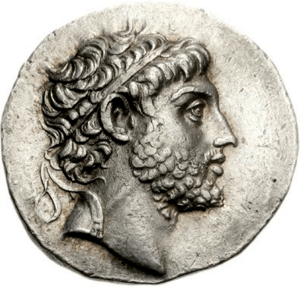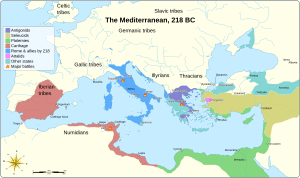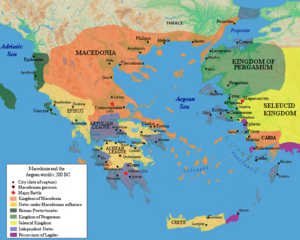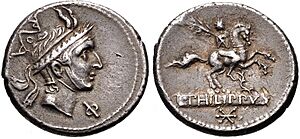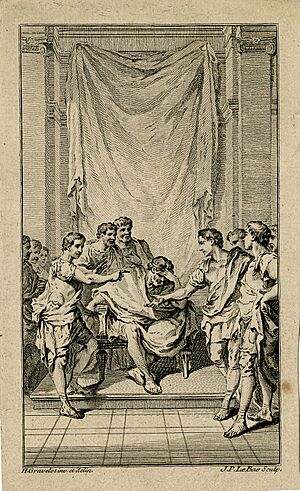Philip V of Macedon facts for kids
Quick facts for kids Philip V |
|
|---|---|
| Basileus | |
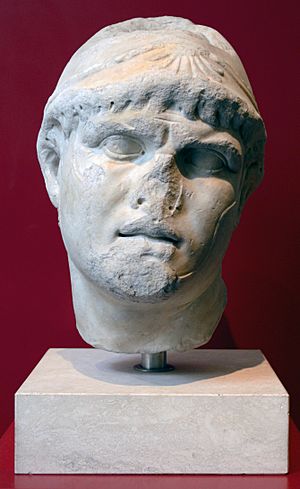
Bust of Philip V inside the Palazzo Massimo, Rome.
|
|
| King of Macedon | |
| Reign | 221–179 BC |
| Predecessor | Antigonus III Doson |
| Successor | Perseus |
| Born | 238 BC Pella, Macedonia |
| Died | 179 BC (aged 59) Amphipolis, Macedonia |
| Spouse | Polycratia |
| Issue | Perseus Apame IV Demetrius Philippus |
| Greek | Φίλιππος (Philippos) |
| House | Antigonid dynasty |
| Father | Demetrius II Aetolicus |
| Mother | Chryseis |
Philip V (Greek: Φίλιππος, romanized: Philippos) was a powerful king of the ancient Greek kingdom of Macedon. He ruled from 221 BC to 179 BC. His time as king was mostly defined by two major things: a war in Greece called the Social War (220-217 BC) and big conflicts with the rising power of the Roman Republic.
Philip led Macedon against Rome in two major wars: the First (212-205 BC) and the Second (200-196 BC). Even though he lost the second war, Philip later teamed up with Rome. He helped them fight against Antiochus III the Great in the Roman-Seleucid War. Philip died in 179 BC after an illness. He had worked hard to make Macedon strong again. His oldest son, Perseus of Macedon, became the next king.
Contents
Early life of Philip V
Philip was the son of Demetrius II of Macedon and a woman named Chryseis. When his father died in 229 BC, Philip was only nine years old. His older half-sister was Apama III.
Philip's great-uncle, Antigonus III Doson, took care of the kingdom. He was first a regent, meaning he ruled until Philip was old enough. Then he became king himself. When Philip was seventeen, in 221 BC, his great-uncle died, and Philip became king.
As a young man, Philip was handsome and had a strong personality. He was a brave and daring warrior. People even compared him to the famous Alexander the Great. He tried to be like Philip II, another great Macedonian king. People said he became "loved by all Greeks" because he was kind to them. He was also very close with Aratus of Sicyon, an important person in his court until 213 BC.
After becoming king, in his first year, Philip V fought back against tribes in the north of Macedonia. These tribes included the Dardani.
The Social War (220–217 BC)
The Social War started in 220 BC. It began after a group of Greek states formed the Hellenic League. This league was created in Corinth in 224 BC by Philip's uncle, Antigonus III Doson. The league included groups like the Achaeans, Acarnanians, and Thessalians.
Philip took over as leader of the Hellenic League in 221/0 BC. He led the league in a three-year war. They fought against Aetolia, Sparta, and Elis. Philip's troops attacked and destroyed Thermum, which was the main city for the Aetolians. They took huge amounts of treasure, including thousands of shields. These shields were from battles the Aetolians had won before.
Philip and his Greek allies won the war. They made peace at a meeting in Naupactus in 217 BC. During this war, Philip V became stronger as a leader. He was well-known and respected by the Greeks for his leadership and military skills.
First Macedonian War (214–205 BC)
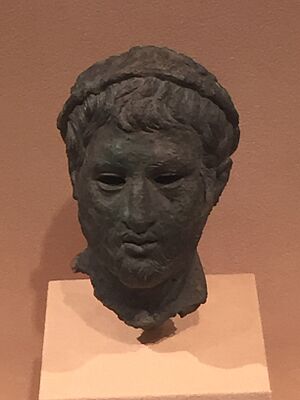
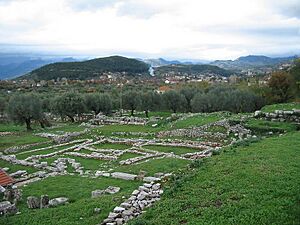
After the peace treaty in 217 BC, Philip V wanted to reduce Rome's power. He focused on the eastern coast of the Adriatic Sea. He tried to invade Illyria by sea, but he didn't have much success at first. His first attempt in 216 BC failed. In 214 BC, he lost his entire fleet. However, a later land attack was more successful. He captured Lissus in 212 BC.
In 215 BC, Philip V signed a special agreement with Hannibal Barca. Hannibal was a famous general from Carthage. This agreement set out what each side would do, but it didn't really help either of them much. Philip V became very busy helping his allies. He protected them from attacks by the Spartans, Romans, and their friends.
Rome made an alliance with the Aetolian League in 211 BC. This stopped Philip from having an advantage on land. When Attalus I of Pergamum joined Rome, Philip's position in Macedonia became even harder. But Philip found an opportunity when Attalus left Greece in 207 BC. Rome also became less active, and Philopoemen of the Achaean League became more important.
Philip and his troops attacked Thermum again. This was the Aetolians' religious and political center. He destroyed everything that was left. In 206 BC, Philip forced the Aetolians to agree to his terms. The next year, 205 BC, he made a peace treaty with Rome and its allies. This was called the Peace of Phoenice.
Expansion in the Aegean Sea
Philip made a deal with the Seleucid king Antiochus III the Great. They agreed to take land from the young Egyptian king Ptolemy V. Philip then invaded Egyptian areas in Asia Minor. He attacked Samos and captured Miletus.
This growth of Macedonian power worried other nearby states. These included Attalid Pergamum and Rhodes. Philip reacted by attacking Attalid land and destroying temples outside Pergamon's walls. The navies of Pergamum and Rhodes fought Philip's fleet in 201 BC. Philip then invaded Caria. Even though the Rhodians and Attalids blocked his fleet, they asked Rome for help.
Around the same time, Rome finally defeated Carthage. Philip's actions in Thrace and Asia Minor didn't directly affect Rome. However, the Roman Senate decided to support Pergamum and Rhodes. They sent a Roman official to investigate. At the same time, Philip's relationship with Athens got worse. The Acarnanian League attacked Attica, helped by Philip's soldiers. Attalus I and Rhodes convinced Athens to declare war on Macedon. Philip sent soldiers to invade Attica and surround Athens.
Second Macedonian War
Roman officials heard reports from Pergamum, Rhodes, and Athens. So, Publius Sulpicius Galba, a Roman leader, was given the job of solving the problems in Macedonia. He officially declared war in March 200 BC. Then he gathered troops and crossed the Adriatic Sea in the autumn.
Meanwhile, Philip was attacking Abydos. During this attack, in autumn 200 BC, a Roman ambassador met Philip. The ambassador told Philip not to attack any Greek state or take land from Ptolemy. He also told him to settle his disagreements with Rhodes and Pergamon. Philip argued that he wasn't breaking any peace agreements, but it didn't help. As he returned to Macedonia after Abydos fell, he learned that the Roman army had landed.
Battles against the Romans
A Roman commander was sent with ships and men to help Athens. He then made a surprise attack on Chalcis in Euboea. This was one of Macedon's key strongholds. Philip quickly rushed to Chalcis with his army. He found that the Roman commander had already left. So, Philip hurried towards Athens. He defeated the Athenian and Attalid troops outside the city. He then tried to attack other places but failed. After that, he destroyed holy sites in Attica and went back to Boeotia. The damage to the countryside and local holy places in Attica was very bad. They were never used again.
During the winter of 200-199 BC, Philip, the Roman commander, and the Athenians tried to make peace. They focused on the Aetolian League, which seemed to support Rome but stayed neutral. In the spring, the Romans and other tribes invaded Upper Macedonia. The Aetolian League joined Rome and attacked Magnesia and Perrhaebia. They then continued to destroy Thessaly. Philip suddenly appeared there and completely defeated them. He tried to attack an Aetolian city but gave up as winter came. He spent the winter training his army and talking with other Greek groups.
Fighting against Flamininus
A new Roman commander, Publius Villius Tappulus, took over. But he spent most of the year dealing with a rebellion among his own soldiers. In summer 198 BC, Philip marched west and set up his camp near the Aoös river. Villius marched to meet him. But before he could decide what to do, he learned that his replacement, Titus Quinctius Flamininus, was on his way.
At a peace meeting, Flamininus announced Rome's new demands. Before, Rome had only told Philip to stop attacking Greek cities. Now, Flamininus demanded that Philip pay back all the Greek cities he had harmed. He also had to remove all his soldiers from cities outside Macedonia, including Thessaly. Thessaly had been part of Macedon since 353 BC. Philip was very angry and left the meeting. Flamininus decided to attack. In the battle that followed, Philip's army was defeated and fled. Philip gathered the survivors and went back to Thessaly.
Over the winter of 198/197 BC, Philip said he was willing to make peace. The groups met in November 198 BC. Philip refused to get off his ship to meet Flamininus and his allies. He spoke to them from the front of his ship. To make things take longer, Flamininus insisted that all his allies had to be at the talks. He then repeated his demands: Philip had to remove all his soldiers from Greece, Illyria, and Asia Minor. Philip was not ready to agree to this. He was convinced to send a group to the Roman Senate. When they reached Rome, the Senate demanded that Philip give up important Greek cities. But Philip's messengers said they didn't have permission to agree to this. So, the war continued. Philip spent the rest of the winter gathering all the men he could for his army.
In June 197 BC, Flamininus marched north with his allies. Philip marched south into Thessaly. The two armies met at the Battle of Cynoscephalae. In this very important battle, the Roman armies defeated Philip's Macedonian army. Philip himself escaped on horseback. He gathered the soldiers who survived and went back to Macedonia. Philip was forced to ask for peace on Rome's terms.
Peace agreement with Rome
In 196 BC, Philip V signed a peace treaty with the Romans. According to the treaty, Philip V had to give up his claim to all Greek cities. This included cities on the mainland and in Asia Minor. He also had to give up important cities like Corinth, Chalcis, and Demetrias. He was also not allowed to cut down trees in the land he controlled. This meant he couldn't build many weapons, like large warships.
After the peace treaty, Philip worked with the Romans. He helped them in their wars against the Spartans in 195 BC. Philip V also supported the Romans against Antiochus III the Great and the Aetolian League. After the Roman–Seleucid War, the Romans allowed Philip V to keep some land he had conquered. This included Demetrias and parts of Thessaly.
Internal reforms and final years
Philip V found ways to make money for his kingdom. He taxed the people of Macedonia. He also used royal properties like mining, forestry, and agriculture. After the Second Macedonian War, Philip V made even more money from farming and mines. Philip focused on making his power stronger within Macedonia. He changed how the country's money and government worked. Mines were reopened, and new currency (money) was made.
However, Rome continued to be suspicious of Philip. Neighboring states, especially Pergamon, kept complaining to Rome about Macedon. Philip felt that Rome might invade Macedon and remove him as king. So, he tried to increase his power in the Balkans using force and diplomacy.
But his efforts were weakened by his younger son, Demetrius. Demetrius supported Rome. Rome encouraged Demetrius to think he might become king instead of his older brother, Perseus. This caused a big argument between Perseus and Demetrius. Philip sadly decided to execute Demetrius for treason in 180 BC. This decision greatly affected Philip's health. He died a year later in 179 BC.
His oldest son, Perseus of Macedon, became king after him. Perseus was the last king of Macedon.
Sources
Primary sources
- Polybius, Histories, Evelyn S. Shuckburgh (translator); London, New York. Macmillan (1889); Reprint Bloomington (1962).
Secondary sources
|
Philip V of Macedon
Born: 238 BC Died: 179 BC |
||
| Preceded by Antigonus III Doson |
King of Macedon 221–179 BC |
Succeeded by Perseus |
See also
 In Spanish: Filipo V de Macedonia para niños
In Spanish: Filipo V de Macedonia para niños


